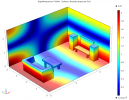- Joined
- May 1, 2021
- Messages
- 427
- Likes
- 1,302
- Introduction -
In a recent interview with Erin of ErinsAudioCorner (https://www.audiosciencereview.com/...ns-with-rene-christensen-of-acculution.28103/), I showed that for steady-state conditions, a loudspeaker moving outwards creates a lower overall pressure, not higher as is often claimed. When doing measurements, you see how pressure relates to voltage only, but when doing simulations you have a much better view into the phase relations along the ‘transductance chain’, and you can come across effects that may go against your initial intuition.
I the following, I will show in very few steps, how you can analytically arrive at the same conclusion, looking at a flat circular piston in an infinite baffle.
- Details -
The complex sound pressure phasor (bold p) relates to the complex velocity phasor (bold U0) as [see e.g. Fundamentals of Acoustics, Kinsler and Frey] for the situation with a piston of radius a in an infinite baffle is:

I have adapted the expression so that z is in the axial direction and r is in the radial direction, and a is the radius, k is the wavenumber, and we have density and sound speed related to the medium.
When putting the observation point directly in the middle of the piston, the expression simplifies to:

We only look at low frequencies where we have a flat frequency response and so we consider that ka is low. We can then approximate the exponential term as:

and inserting back into the original expression we get:

or

Since acceleration relates to velocity as

we can finally arrive at

and we see that the pressure is in-phase with acceleration, which in turn is in anti-phase with displacement. Hence, at the piston’s outermost position into the medium, the acceleration is negative and so is the sound pressure.
- Conclusion -
A piston in a baffle creates the lowest total pressure (negative sound pressure) when it has moved all the way out, not in. This is also seen in more typical electrodynamic driver setups.
You should always be careful when carrying around knowledge that came out of intuition or “it is well-known in this industry that…”-thinking, where you trust what is being said within the company that you are in. Once in a while, it can affect the engineering decisions in ways that can cost a lot of time and money to course correct once the problems show up. Try and work from first principles whenever you can.
- About me -
René (no need for Dr title, please), BSEE, MSc (Physics), PhD (Microacoustics), FEM and BEM simulations specialist. Own consultancy company Acculution ApS, and blog at acculution.com/blog
In a recent interview with Erin of ErinsAudioCorner (https://www.audiosciencereview.com/...ns-with-rene-christensen-of-acculution.28103/), I showed that for steady-state conditions, a loudspeaker moving outwards creates a lower overall pressure, not higher as is often claimed. When doing measurements, you see how pressure relates to voltage only, but when doing simulations you have a much better view into the phase relations along the ‘transductance chain’, and you can come across effects that may go against your initial intuition.
I the following, I will show in very few steps, how you can analytically arrive at the same conclusion, looking at a flat circular piston in an infinite baffle.
- Details -
The complex sound pressure phasor (bold p) relates to the complex velocity phasor (bold U0) as [see e.g. Fundamentals of Acoustics, Kinsler and Frey] for the situation with a piston of radius a in an infinite baffle is:
I have adapted the expression so that z is in the axial direction and r is in the radial direction, and a is the radius, k is the wavenumber, and we have density and sound speed related to the medium.
When putting the observation point directly in the middle of the piston, the expression simplifies to:
We only look at low frequencies where we have a flat frequency response and so we consider that ka is low. We can then approximate the exponential term as:
and inserting back into the original expression we get:
or
Since acceleration relates to velocity as
we can finally arrive at
and we see that the pressure is in-phase with acceleration, which in turn is in anti-phase with displacement. Hence, at the piston’s outermost position into the medium, the acceleration is negative and so is the sound pressure.
- Conclusion -
A piston in a baffle creates the lowest total pressure (negative sound pressure) when it has moved all the way out, not in. This is also seen in more typical electrodynamic driver setups.
You should always be careful when carrying around knowledge that came out of intuition or “it is well-known in this industry that…”-thinking, where you trust what is being said within the company that you are in. Once in a while, it can affect the engineering decisions in ways that can cost a lot of time and money to course correct once the problems show up. Try and work from first principles whenever you can.
- About me -
René (no need for Dr title, please), BSEE, MSc (Physics), PhD (Microacoustics), FEM and BEM simulations specialist. Own consultancy company Acculution ApS, and blog at acculution.com/blog
Last edited:


